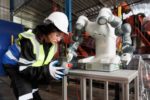
Think Tank
Three Technologies Helping Service Providers Work More Efficiently

A man uses a smartphone. Photo: Shutterstock.
Service organizations, like many others, are feeling the effects of today’s talent shortage.
Recent figures from the U.S. Bureau of Labor Statistics show the number of people deciding to leave their job has reached 3% — an all-time high — as unemployment numbers remain low. A silver tsunami of baby boomers leaving the workforce is growing, and younger generations are increasingly choosing gig work or independent contracting over full-time employment.
Jobs in engineering and field services are among the most challenging positions to fill, but employers can find support in three next-gen technologies — backed by data — that drive efficiency and productivity.
Predictive Maintenance
Some workforce efficiencies occur even before a service engineer is dispatched. With advances in artificial intelligence (AI) and machine learning (ML), maintenance becomes more predictive, and when repair is needed, the best technician is automatically assigned to a work order based on the nature of the call, experience and skill set, geographical location, and even the equipment and parts available on the truck. As a result, maintenance schedules are more effective and efficient, first-time fix rates increase, truck rolls go down, leaving more time in the day for additional high value customer interactions and greater employee engagement.
As with any technology-based company, service organizations must continually optimize and evolve the data they already have to not only think about predictive motions for assets and equipment, but also for knowledge transfer among front-line workers, service engineers and technicians.
There are examples of many service organizations using existing infrastructure to optimize where and how technicians spend their time, even where it would have seemed too challenging in the past. Associa, a community management organization with over 9,000 employees, leveraged its Field Service Management (FSM) platform to increase the mobility of its service technicians. The change was simple, but highly impactful.
Instead of requiring technicians to clock in and receive work orders at the office each morning, Associa evolved to a mobile-first model and sent orders directly to each technician. This allowed workers to skip a daily visit to the office. The result? A full two hours of non-productive time is eliminated daily for each and every technician.
Smarter ERP
Making maintenance more predictive and completing a job on the first visit allows organizations to cover more service calls over time using a limited workforce. Yet often, many service technicians are unable to access the data and parts they need prior or upon arrival, increasing the likelihood of a second visit.
Ainsworth, a multi-trade company that provides a range of skilled technical trade services such as HVAC, mechanical, electrical, motor, power, and more across a range of companies, knew it could do more with its data to help drive greater efficiencies in its field operations. The organization focused on data accuracy and access by integrating their enterprise resource planning (ERP) system with their FSM solution to ensure precise and real-time data was available to workers in the field.
Working with smart devices, technicians can complete work orders, communicate with dispatchers, and respond to any other issue that may arise during a call. Along with an increase in first-time fixes, these advances contribute to higher customer satisfaction levels since fewer service cycles are required to resolve an issue. Next step is how to continue to drive knowledge management and training in the workforce and factor that into each process for greater “self-learning” alongside customer experience.
There is also an added skills gap benefit to keeping critical data tightly integrated into enterprise software systems. According to Deloitte, 32% of service organizations build knowledge transfer programs to pass on skills between retiring and new workers. Knowledge management can be built into enterprise software to provide automated data capture, user-friendly mobile apps with prompts, and guides to complete tasks — all supporting digital knowledge transfer from more experienced technicians to new recruits.
Augmented Reality
And we can take this knowledge transfer a step further with enabling technologies such as augmented and merged reality (AR/MR) tools and more remote service capabilities built into assets and equipment. Here delivering service completely remotely isn’t an option, effectiveness in the field can be enhanced by using an over the shoulder view presented on tablets or smartphones. This allows service organizations to provide additional support for newer technicians with access to senior personnel via live video or other digital platforms.
Senior leaders can help guide the technician through the repair so they can learn in the moment. This model also provides more first-time fix outcomes and faster times to resolution.
This technology is now providing service organizations with a means to efficiently interact with customers without making physical contact, increasing productivity and reducing drive time as well to save on fuel. AR/MR tools allow service organizations to effectively eliminate drive time, converting these non-productive technician hours into face-to-face customer interactions.
Munters, a provider of sustainable air treatment and climate solutions, is a perfect example of how AR/MR technology can provide a mix of real and virtual worlds to drive better customer outcomes. The company was looking for a robust remote assistance tool to move towards a fully servitized, outcome-based business model. The enforced travel restrictions of the pandemic provided additional impetus for Munters to quickly implement a solution that could support ways of sharing expertise in a manner that is safe for customers and employees alike. It was able to pilot and roll out remote assistance technology for 200 staff across 22 countries in just two weeks.
The skills shortage we are experiencing isn’t something that will be short-term, nor something that can be resolved overnight. With the support of digital and vocational skills training, alongside technology-led solutions, service organizations can better optimize technician utilization, improve knowledge transfer and, ultimately, deliver better customer service. All of this mitigates the skills and talent crunch and eases the issues the service sector is currently experiencing.
Marne Martin is president of service management, EAM and global industries at IFS.






